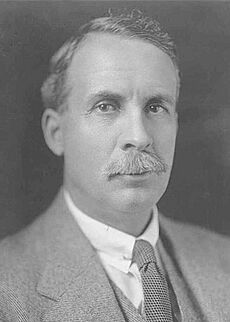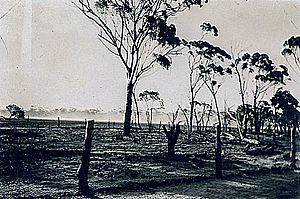Emu War facts for kids
Quick facts for kids Emu War |
|
|---|---|
| Location | Campion district, Western Australia |
| Planned by | Sir George Pearce |
| Objective | Reduce the local emu population |
| Date | 2 November – 10 December 1932 (1 month, 1 week and 1 day) |
| Executed by | |
| Outcome | 986 emus confirmed killed. Minimal impact on the overall emu population. |
The Emu War was a strange event in Australia in late 1932. It was a military operation where soldiers tried to control a large number of emus. These emus were causing big problems for farmers in the Campion area of Western Australia. The farmers said the emus were destroying their crops. Soldiers from the Royal Australian Artillery used Lewis guns, which are a type of machine gun, to try and stop the emus. Even though many emus were killed, the "war" didn't really work. The emu population stayed strong and kept damaging crops.
Contents
Why the Emu War Started
After World War I, many soldiers who had fought in the war were given land by the Australian government. They were meant to become farmers in Western Australia. Often, this land wasn't the best for farming.
Then, the Great Depression hit in 1929. This was a time when the economy was very bad. The government told farmers to grow more wheat and promised to help them with money. But the government didn't keep its promise. Wheat prices kept falling. By October 1932, farmers were struggling. They were getting ready to harvest their crops but were also threatening to stop selling their wheat.
Their problems got much worse when about 20,000 emus arrived. Emus usually move from inland areas to the coast after they have their babies. But the farmers had cleared land and added water for their animals. The emus found these farms to be great places to live. They started going into the farm areas, especially near Chandler and Walgoolan.
The emus ate and ruined the crops. They also made big holes in fences. This allowed rabbits to get in and cause even more damage.
Farmers Ask for Help
Farmers told the government how worried they were about the emus. A group of ex-soldiers, who were now farmers, met with the Minister of Defence, Sir George Pearce. These soldier-farmers knew how powerful machine guns were from the war. They asked for machine guns to be used against the emus.
Sir George Pearce quickly agreed, but he had some rules. Soldiers had to use the guns. The Western Australian government had to pay for the soldiers' travel. The farmers would provide food, a place to stay, and pay for the bullets.
Pearce also thought it would be good target practice for the soldiers. Some people believe the government also wanted to show they were helping the farmers. This was also a time when some people in Western Australia wanted to leave Australia and become their own country. The government wanted to avoid that. A filmmaker from Fox Movietone was even brought in to record the event.
The "War" Begins

The military operation was supposed to start in October 1932. Major Gwynydd Purves Wynne-Aubrey Meredith was in charge. He was from the Royal Australian Artillery. He commanded two soldiers, Sergeant S. McMurray and Gunner J. O'Halloran. They had two Lewis guns and 10,000 bullets.
The start of the operation was delayed because of rain. The rain made the emus spread out over a larger area. The rain stopped by 2 November 1932. The soldiers were then sent out. Their orders were to help the farmers. A newspaper also said they were to collect 100 emu skins. The feathers from these skins would be used for hats for light horsemen.
First Attempt to Control Emus
On 2 November, the soldiers went to Campion. They saw about 50 emus. The birds were too far away for the guns. Local farmers tried to guide the emus into a trap. But the birds split into small groups and ran. This made them hard to shoot.
Still, the first shots from the machine guns didn't work because of the distance. But a second round of shooting killed "a number" of birds. Later that day, they found a small group and killed "perhaps a dozen" more.
The next big event was on 4 November. Major Meredith set up a trap near a local dam. More than 1,000 emus were seen heading towards them. This time, the gunners waited until the birds were very close before shooting. But the gun jammed after only 12 birds were killed. The rest of the emus ran away before more could be shot. No more birds were seen that day.
In the days that followed, Meredith moved further south. People said the birds there were "fairly tame." But even with his efforts, they had little success. By the fourth day, army observers noticed something interesting. They said, "each pack seems to have its own leader now." This leader was a "big black-plumed bird" that stood "fully six feet high." It would watch out while its group ate crops and warn them when the soldiers came near.
At one point, Meredith even put one of the guns on a truck. But this didn't work well. The truck couldn't catch up to the fast birds. The ride was also so bumpy that the gunner couldn't shoot accurately. By 8 November, six days after they started, 2,500 bullets had been fired. No one was sure how many birds were killed. One report said 50, but others said between 200 and 500. The farmers said 500. Major Meredith's official report said his men were not hurt at all.
A bird expert named Dominic Serventy later said that the soldiers' hopes of shooting many emus at once were quickly gone. He said the emus seemed to use "guerrilla tactics." Their large group split into many small ones. This made using military equipment not worth it. So, the soldiers left the area after about a month.
On 8 November, members of the Australian House of Representatives talked about the operation. Local news had reported negatively, saying "only a few" emus had died. Because of this bad publicity, Sir George Pearce pulled the soldiers and guns out on 8 November.
After the soldiers left, Major Meredith compared the emus to Zulus. He was amazed at how well the emus could move, even when they were badly hurt. He said, "If we had a military division with the bullet-carrying capacity of these birds it would face any army in the world... They can face machine guns with the invulnerability of tanks. They are like Zulus whom even dum-dum bullets could not stop."
Second Attempt to Control Emus

After the military left, the emus kept attacking crops. Farmers again asked for help. They said the hot weather and drought were making thousands of emus invade their farms. James Mitchell, who was the Premier of Western Australia, strongly supported getting military help again. At the same time, a report came out saying 300 emus had been killed in the first attempt.
Because of these requests and the report, the Minister of Defence approved sending the military back by 12 November. He defended his decision in the Senate. He explained why soldiers were needed to fight the serious threat from the large emu population. The military had agreed to lend the guns to the Western Australian government. They expected the state to provide the people to use them. But because there weren't enough experienced machine gunners in the state, Major Meredith was sent back out.
The soldiers returned on 13 November 1932. They had some success in the first two days, killing about 40 emus. The third day, 15 November, was not as successful. But by 2 December, the soldiers were killing about 100 emus each week. Major Meredith was called back on 10 December. In his report, he said they had 986 confirmed kills. They used 9,860 bullets, meaning exactly 10 bullets per confirmed kill. Meredith also claimed that exactly 2,500 wounded birds later died from their injuries.
An article in the Coolgardie Miner on 23 August 1935 looked back at the operation. It said that even though using machine guns was "criticised in many quarters," the method worked and saved what was left of the wheat.
What Happened After
Even with all the problems, farmers in the area asked for military help again in 1934, 1943, and 1948. But the government said no each time. Instead, they continued a system where people were paid for each emu they killed. This system had started in 1923. It worked well: 57,034 payments were claimed in just six months in 1934.
By December 1932, news of the Emu War had spread to the United Kingdom. Some people who cared about animals protested. They said it was "extermination of the rare emu." Dominic Serventy and Hubert Whittell, who were famous Australian bird experts, called the "war" "an attempt at the mass destruction of the birds."
Throughout the 1930s and later, building exclusion barrier fencing became a popular way to keep emus out of farm areas. These fences also helped keep out other vermin, like dingoes and rabbits.
In November 1950, Hugh Leslie brought up the emu problem in the Australian parliament. He asked the Army Minister, Josiah Francis, to give some .303 ammunition from the army to farmers. The minister approved giving out 500,000 bullets.
Legacy of the Emu War
In 2019, a musical play about the Emu War was developed in Melbourne. It was written by Simeon Yialeloglou and had music by James Court. An action-comedy movie called The Emu War was shown for the first time at Monster Fest on 22 October 2023. Another action-comedy movie about the events is being planned. It is written by John Cleese, Monty Franklin, Rob Schneider, Camilla Cleese, and Jim Jefferies. It was hoped to start making it in 2023 or 2024.
Images for kids
See also
 In Spanish: Guerra del Emú para niños
In Spanish: Guerra del Emú para niños
- Four Pests campaign
- Rabbits in Australia
- Dingo Fence






